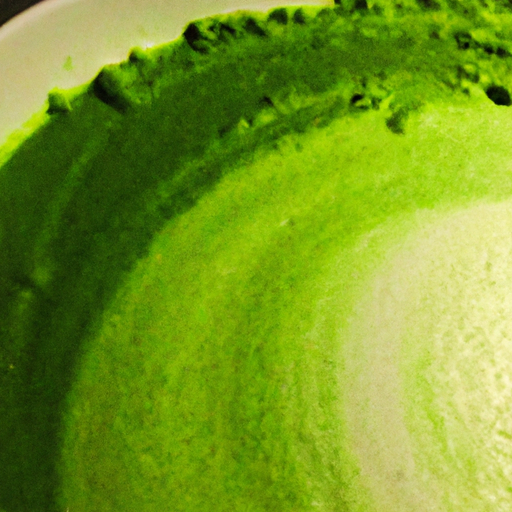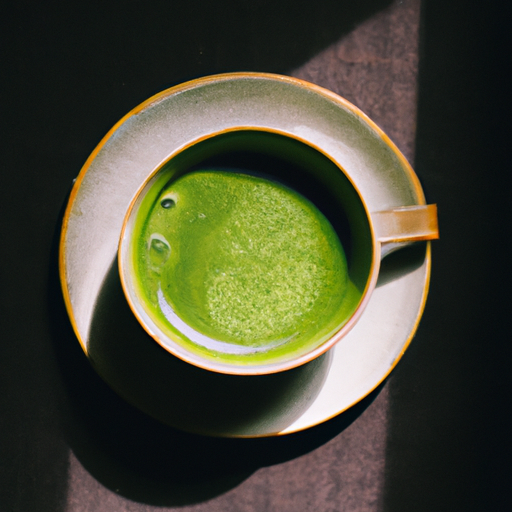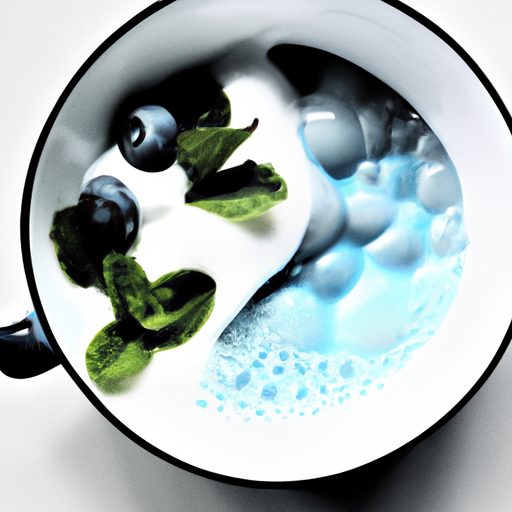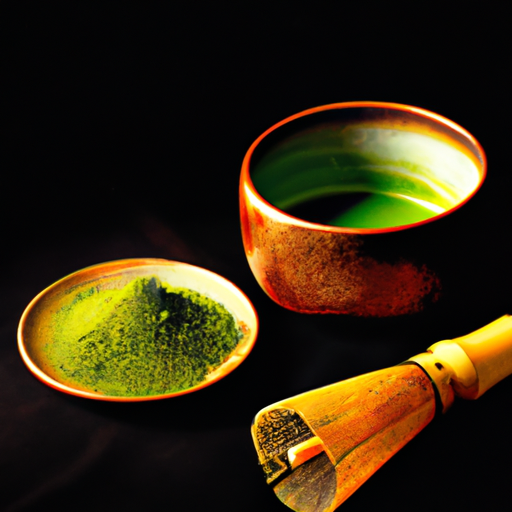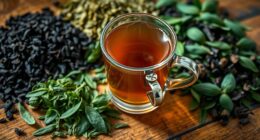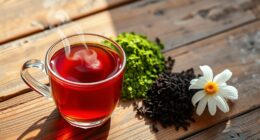Have you ever pondered what color matcha is?
I know I certainly did when I first heard about this trendy green tea powder. As a tea enthusiast, I was intrigued by the unique growing and harvesting process of matcha and the vibrant hue it produces.
After doing some research and tasting various types of matcha, I discovered that the color of matcha can vary depending on several factors.
In this article, I will take you through the journey of matcha, from the growing and harvesting process to the different shades and qualities of matcha, and even creative ways to use it in your cooking and baking.
So, let’s dive into the world of matcha and explore what color it really is.
Key Takeaways
- The shade of green in matcha is influenced by the amount of sunlight and the shading process during the growing season.
- Matcha is graded based on color, texture, taste, and aroma, with ceremonial grade being the youngest and most tender leaves with a vibrant green color.
- The shading process used in matcha production slows down growth and increases chlorophyll production, resulting in a brighter green color and more delicate, sweet taste.
- Matcha is available in both ceremonial and culinary grades, with the former being ideal for drinking as tea or latte, and the latter being more robust in flavor and ideal for cooking and baking.
What is Matcha?
Matcha is a powdered green tea that originated in Japan. It’s made from shade-grown tea leaves, which are ground into a fine powder. Unlike other teas, matcha is consumed in its entirety, with the leaves and all. This means that when you drink matcha, you’re consuming all the nutrients and antioxidants that the tea leaves contain.
Matcha has numerous health benefits. It’s high in antioxidants, which can help protect against cancer and other chronic diseases. Matcha also contains caffeine, which can provide a boost of energy without the crash that comes from drinking coffee. Additionally, matcha is high in L-theanine, an amino acid that can help promote relaxation and reduce stress.
Matcha is an important part of traditional Japanese tea ceremonies. These ceremonies are often steeped in tradition and symbolism, with every step carefully planned and executed. Matcha is typically served in a small bowl, and guests are expected to sip the tea in a certain way.
Understanding the growing and harvesting process of matcha is essential for appreciating the tea’s flavor and significance in Japanese culture.
Understanding the Growing and Harvesting Process
As I’m learning about how matcha is grown and harvested, I’m beginning to appreciate the hard work and dedication that goes into producing this beloved Japanese tea.
The growing season for matcha is quite short, typically only lasting from late April to early May. During this time, the tea plants are shaded from the sun to slow down their growth and increase their chlorophyll production, which contributes to matcha’s vibrant green color.
Once the leaves are harvested, they undergo a careful process of steaming, drying, and grinding to create the fine powder that we know as matcha. One important factor that affects matcha’s quality and color is leaf oxidation. If the leaves are left to oxidize for too long, they will turn brown and lose their vibrant green hue.
This is why matcha is harvested and processed as quickly as possible, to ensure that the leaves retain their bright green color.
Understanding the growing and harvesting process of matcha can give us a deeper appreciation for this special tea. However, there are also other factors that affect the color of matcha, such as the cultivation techniques used and the age of the tea leaves.
In the next section, we’ll explore these factors in more detail to gain a better understanding of what gives matcha its unique color.
Factors That Affect the Color
You may be curious about what influences the vibrant green hue of this beloved Japanese tea. There are several factors that affect the appearance of matcha.
One of the most important factors is the amount of sunlight the tea leaves receive. The more sunlight the tea leaves receive, the darker the shade of green they will be. This is why matcha that is grown in shaded areas tends to have a brighter green color compared to those grown in direct sunlight.
Another factor that affects the color of matcha is the time of harvest. Matcha that is harvested earlier in the season tends to have a milder, lighter flavor and a brighter green color. As the season progresses, the tea leaves become more mature and the color of the matcha becomes darker. The flavor of the matcha also becomes more robust and complex.
In addition to these factors, the method of processing also plays a role in the appearance of matcha. The leaves are carefully dried and ground into a fine powder, which is then sifted to remove any impurities. The quality of the matcha can be determined by the color, texture, and aroma of the powder.
With all these factors combined, it’s no wonder why matcha is such a unique and exquisite tea. In the next section, we’ll explore the different shades of matcha and what they mean.
The Different Shades of Matcha
When it comes to selecting the perfect shade of matcha, the saying ‘variety is the spice of life’ certainly rings true. Matcha is available in different grades, which are determined by the cultivation and processing methods. Each grade has a distinct shade of green, which can range from bright emerald to pale jade. The different shades of matcha are not only aesthetically pleasing but also play a significant role in determining the taste and quality of the tea.
The different grades of matcha have varying shades of green, and this is determined by the age of the tea leaves used. The highest grade of matcha, ceremonial grade, is made from the youngest and most tender leaves, and is known for its vibrant green color. The culinary grade, on the other hand, is made from slightly older leaves and has a darker green hue. The color of matcha is also influenced by the shading process that the tea plants undergo before harvesting.
This process involves covering the plants for about three weeks to increase the production of chlorophyll, which gives matcha its vibrant green color. Matcha’s color is not just a visual aspect but also an indication of its taste and quality. The brighter the green, the more delicate and sweet the taste. Ceremonial grade matcha has a smooth and creamy texture with a sweet finish, making it perfect for drinking as a tea or a latte. Culinary grade matcha, with its darker green shade, has a more robust flavor that makes it ideal for cooking and baking.
The color of matcha is, therefore, an essential aspect to consider when selecting the right type for your culinary uses. The shade of matcha is just the first aspect to consider when selecting the right type of matcha. The next step is to determine the taste and quality. While the color of matcha plays a role in determining these aspects, it is not the only factor.
The subsequent section will delve into the taste and quality of matcha, and how they are determined by factors such as cultivation, processing, and storage.
Taste and Quality
The flavor profile and overall quality of matcha can vary greatly depending on factors such as cultivation, processing, and storage, making it important to carefully consider these elements when selecting the perfect matcha for your needs.
Here are some tasting notes to help you understand the range of flavors in matcha:
- Ceremonial grade matcha has a smooth, creamy texture with a sweet, grassy flavor and a hint of umami.
- Premium grade matcha has a stronger umami flavor with a slightly bitter finish, making it ideal for lattes and other mixed drinks.
- Culinary grade matcha has a more astringent, earthy flavor that pairs well with other ingredients in cooking and baking.
- Low-quality matcha can have a bitter, chalky taste and a dull green color due to poor cultivation and processing.
In order to ensure you get the best matcha for your needs, it’s important to understand the grading system. Matcha is typically graded based on color, texture, taste, and aroma. Higher grades of matcha are made from younger tea leaves that are carefully shaded and processed, resulting in a brighter green color and more delicate flavor. Lower grades of matcha may be made from older leaves or may contain stems and other impurities, resulting in a lower quality product.
When choosing the right matcha, it’s important to consider the intended use, as well as personal taste preferences. Whether you’re looking for a rich, creamy latte or a flavorful ingredient for your favorite recipe, selecting the right grade and quality of matcha can make all the difference.
How to Choose the Right Matcha
To find the perfect matcha for your needs, it’s essential to consider factors such as cultivation, processing, and storage, and carefully examine the flavor profile and overall quality.
Matcha is graded according to its quality, with the highest grade being ceremonial grade matcha. This grade is made from the youngest tea leaves, which are shade-grown to enhance their sweetness and reduce bitterness. Although it’s more expensive than other grades, it’s the best choice for those who want to experience the authentic taste and aroma of matcha.
When choosing matcha, it’s also important to consider your taste preferences. Matcha can have a range of flavors, from sweet and vegetal to bitter and nutty. Some people prefer a sweeter, milder flavor, while others enjoy the bitterness that comes from higher quality matcha. It’s important to taste a variety of matcha before making a decision, and to choose a grade and flavor profile that suits your personal preferences.
In addition to taste, storage is also a crucial factor in maintaining the quality of matcha. To keep matcha fresh and flavorful, it should be stored in an airtight container in a cool, dark place. It’s best to use matcha within a few weeks of opening the container, as exposure to air and light can cause it to lose its flavor and color.
By considering factors such as grade, taste preferences, and storage, you can choose the perfect matcha for your needs and enjoy its delicious flavor and health benefits. As for storing matcha, there are a few key steps you can take to ensure that it stays fresh and flavorful.
How to Store Matcha
Now that you’ve learned how to choose the right matcha, let’s talk about how to store it properly. Matcha is a delicate tea that requires proper storage to maintain its freshness and quality. Improper storage can lead to a bitter taste and a shortened shelf life.
The best way to store matcha is to keep it in an airtight container in a cool, dry, and dark place. Avoid exposing it to direct sunlight, heat, or moisture. I prefer to use a ceramic or glass container with a tight-fitting lid to keep out air and moisture.
Properly stored matcha can last up to six months, but it’s best to use it within three months to enjoy its full flavor and aroma. When it comes time to prepare your matcha, you’ll want it to be fresh and vibrant, so make sure to store it correctly.
Now, let’s move on to the next section and learn how to prepare matcha.
How to Prepare Matcha
First things first, let’s talk about how you can prepare your matcha tea for a delicious and satisfying experience. To make a classic matcha tea, you’ll need a bowl, a bamboo whisk, and a spoon. Here are the steps:
- Sift 1-2 teaspoons of matcha into a bowl to remove any clumps.
- Add hot water (not boiling, around 170°F) to the bowl and whisk briskly in a zig-zag motion until frothy.
- Enjoy your frothy and smooth matcha tea!
If you want to switch things up, you can try making a matcha latte instead. Here’s a simple recipe:
-
Sift 1-2 teaspoons of matcha into a bowl.
-
In a separate cup, heat up milk (or plant-based milk) and froth it with a milk frother or whisk.
-
Add the frothed milk into the bowl with matcha and mix well. Sweeten with honey or sugar if desired.
Aside from its delicious taste, drinking matcha also has many health benefits. Matcha is rich in antioxidants, boosts metabolism, and promotes relaxation and focus. Incorporating matcha into your daily routine can be a great way to support your overall well-being.
Now that you know how to prepare matcha and the benefits of drinking it, let’s move on to creative ways to use matcha in cooking and baking.
Creative Ways to Use Matcha
I absolutely love using matcha in my cooking and baking! It adds a unique and earthy flavor to any dish.
Some of my favorite ways to use matcha include adding it to cookies, muffins, and even pancakes. But it’s not just limited to baked goods.
I also love incorporating matcha into smoothies and drinks for a healthy boost of antioxidants.
Baking
You think baking with matcha will be easy, don’t you? Well, get ready for a green disaster. As someone who’s attempted baking with matcha powder, I can tell you that it takes a bit of practice and patience to get it right. However, once you do, the results are incredibly delicious and visually stunning.
Here are some tips and recipe ideas to help you master the art of baking with matcha:
- Use high-quality matcha powder to ensure a vibrant green color and authentic taste.
- Sift the matcha powder before adding it to the recipe to avoid clumps.
- Use a small amount of matcha powder at first, and gradually increase the amount until you achieve the desired flavor and color.
- Balance the bitterness of matcha with sweet ingredients, such as sugar or white chocolate.
- Experiment with different baking techniques, such as adding matcha to dough, batter, or frosting, to find what works best for your recipe.
Now, let’s move on to the next section about cooking, where we’ll explore more ways to incorporate matcha into your culinary creations.
Cooking
After exploring the world of matcha in baking, I can’t wait to dive into its potential in cooking. Cooking with matcha involves a different set of techniques and flavor profiles, one that I’m excited to explore.
When it comes to cooking with matcha, it’s important to understand that its unique flavor can be easily overwhelmed by other ingredients. This means that subtle cooking techniques are key to highlighting its flavor.
One popular technique is to use matcha as a rub for meats, such as chicken or fish. This allows the flavor to seep into the meat without being overpowered.
Another technique is to use matcha as a seasoning in sauces or dressings, adding a subtle earthy flavor to the dish.
As I explore the world of matcha in cooking, I can’t wait to experiment with these techniques and more. But before I move on to smoothies and drinks, let’s keep exploring how matcha can enhance our cooking.
Smoothies and drinks
Get ready to experience the creamy, refreshing taste of matcha in your favorite smoothies and drinks! Matcha is a versatile ingredient that can be used in many different ways, and adding it to your drinks is a great way to reap its health benefits.
There are plenty of matcha recipes out there that you can try, from simple smoothies to more complex drinks that incorporate other flavors and ingredients. One popular matcha drink is the matcha latte, but if you’re looking for something a little different, there are plenty of matcha latte alternatives that you can try.
For example, you could make a matcha coconut smoothie by blending together matcha powder, coconut milk, banana, and ice. Or, you could make a matcha lemonade by mixing matcha powder with lemon juice, agave syrup, and water. The possibilities are endless, so don’t be afraid to get creative and experiment with different matcha recipes!
Frequently Asked Questions
What are the health benefits of matcha?
I absolutely love matcha and I’m excited to share its many health benefits with you!
Matcha is packed with antioxidants, which can help prevent chronic diseases and boost your immune system. It also contains caffeine and L-theanine, which work together to give you a sustained energy boost without the jitters.
Additionally, matcha has been shown to aid in weight loss by boosting metabolism and burning fat. There are so many delicious matcha recipes out there, from lattes to smoothie bowls to baked goods.
Incorporating matcha into your diet is a great way to add a burst of flavor and nutrition to your day.
How does the taste of matcha differ from other types of tea?
When it comes to taste, matcha has a unique flavor profile that sets it apart from other types of tea. As someone who’s tried various teas, I can confidently say that matcha has a bold, earthy flavor that’s both strong and sweet at the same time.
Unlike regular tea, matcha is made by grinding up whole tea leaves into a fine powder, which gives it a richer taste. To get the best taste out of matcha, it’s important to use proper brewing techniques. For example, whisking the powder with hot water to create a frothy texture.
With its distinct taste and preparation methods, matcha is definitely worth trying for tea enthusiasts looking for something new and exciting.
Can matcha be used in cooking or baking?
Yes, matcha can definitely be used in cooking and baking! There are tons of matcha recipes out there, from matcha lattes to matcha desserts and even savory dishes.
To use matcha in cooking, you’ll want to make sure you’re using high-quality culinary grade matcha powder. You can mix it into batters and doughs, or sprinkle it on top of finished dishes as a garnish.
When it comes to cooking techniques for matcha, you’ll want to be careful not to overheat it, as this can cause the flavor to become bitter. It’s best to mix matcha powder with cooler ingredients and avoid using it in recipes that require high heat.
With a bit of experimentation, you can easily incorporate matcha into your cooking and baking repertoire!
How long does matcha stay fresh after opening?
Storing matcha properly is crucial to ensure its freshness. The shelf life of matcha can vary, but generally it can last up to a year if stored correctly. After opening, matcha should be consumed within three to six months for optimum freshness.
The best ways to keep matcha fresh include storing it in an airtight container away from moisture, light, and heat. It’s also recommended to keep matcha in the refrigerator or freezer to prolong its shelf life.
By following these tips, you can enjoy the full flavor and benefits of matcha for a longer period of time.
What is the traditional Japanese tea ceremony and how does matcha feature in it?
The traditional Japanese Tea Ceremony, also known as the Way of Tea, is a cultural practice that emphasizes harmony, respect, purity, and tranquility. Matcha, a powdered green tea, plays a significant role in this ceremony.
The preparation of matcha is a meticulous process that involves whisking the powdered tea with hot water until it forms a frothy emulsion. The tea is then served in a bowl, with the guest receiving the bowl turning it clockwise before drinking.
The ceremony involves many intricate movements and gestures, including the use of specific utensils and the appreciation of the tea’s aroma, flavor, and texture. The preparation techniques of matcha for the Japanese Tea Ceremony are precise and require years of practice to perfect.
The ceremony is a beautiful and meaningful way to honor the tea and the connection it brings between the host and guests.
Conclusion
Well folks, we’ve learned a lot about matcha today. We’ve covered the growing and harvesting process, the factors that affect the color, and the different shades of matcha. We’ve even talked about taste and quality, and how to choose the right matcha for you.
But let’s be real, the most important thing we’ve learned today is what color matcha is. And the answer is…drumroll please…green. Yes, that’s right, matcha is green. I know, shocking right? But fear not, now that we’ve cleared that up, you can rest assured that you won’t accidentally mistake your matcha for a different color.
In all seriousness though, matcha is a wonderful ingredient that can be used in a variety of creative ways. Whether you’re looking to make a traditional cup of matcha tea, or you want to experiment with adding matcha to your favorite recipes, there’s no shortage of ways to enjoy this delicious and healthy ingredient.
So go ahead, get creative, and have some fun with matcha. Just remember, it’s green.

